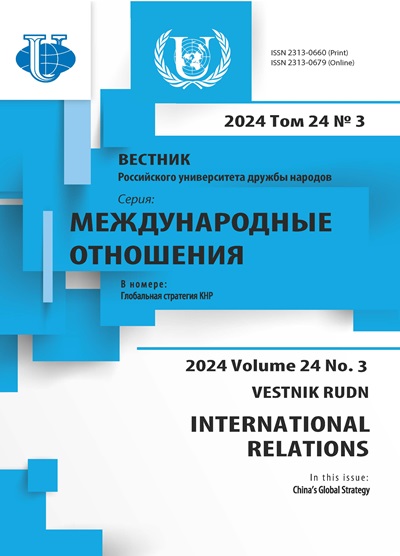К ГЛОБАЛЬНОЙ СТРАТЕГИИ МЕЖДУНАРОДНОЙ ПОМОЩИ ОАЭ: ОТ АРАБСКОЙ СОЛИДАРНОСТИ К СОТРУДНИЧЕСТВУ ЮГ-ЮГ
- Авторы: Альмезаини Х.1,2
-
Учреждения:
- Университет Зайда
- Объединенные Арабские Эмираты Кембриджский университет
- Выпуск: Том 18, № 3 (2018): Перспективы сотрудничества Юг—Юг. К 40-летию Буэнос-Айресского плана действий
- Страницы: 579-594
- Раздел: ТЕМАТИЧЕСКОЕ ДОСЬЕ
- URL: https://journals.rudn.ru/international-relations/article/view/20105
- DOI: https://doi.org/10.22363/2313-0660-2018-18-3-579-594
Цитировать
Полный текст
Аннотация
Статья посвящена феномену деятельности «новых доноров» в рамках сотрудничества Юг- Юг. Пример оказания международной помощи Объединенными Арабскими Эмиратами (ОАЭ) демонстрирует новые принципы и инструменты сотрудничества Юг-Юг; прежде всего, это солидарность и взаимодействие с ООН и другими правительственными и неправительственными организациями по оказанию помощи в целях содействия развитию стран «Глобального Юга». Положение ОАЭ на региональном (ближневосточном) и международном уровне обязывает страну к оказанию всех видов помощи, особенно гуманитарной. По сути, ОАЭ являются «гуманитарной нацией», где содействие развитию становится частью ежедневной внешнеполитической деятельности государства. Следовательно, отношения ОАЭ со странами Юга и так называемыми «развивающимися странами» стали развиваться в достаточно активном режиме, поскольку ОАЭ способствуют экономическому росту этих государств. Сотрудничество Юг-Юг включает в том числе обмен технологий и ресурсов между развивающимися странами. Используя преимущественно количественную методологию, автор анализирует стратегию внешней помощи ОАЭ и подтверждает ее согласованность с Целями устойчивого развития и Целями развития тысячелетия, объявленными ООН. Более того, автор показывает расширение географии иностранной помощи ОАЭ: крупнейшими получателями помощи ОАЭ в основном являются государства Азии и Африки, где находятся самые бедные страны мира.
Об авторах
Халид Альмезаини
Университет Зайда; Объединенные Арабские Эмираты Кембриджский университет
Автор, ответственный за переписку.
Email: k.almezaini@gmail.com
доцент Университета Зайда, Абу-Даби, ОАЭ; научный сотрудник Кембриджского университета, Великобритания
Список литературы
- Almezaini, K. (2012). The UAE and Foreign Policy: Foreign Aid, Identities and Interests. Culture and Civilization in the Middle East. London: Routledge.
- Almezaini, K. (2017). From Identities to Politics: UAE Foreign Aid. In: South-South Cooperation Beyond the Myths Rising Donors, New Aid Practices? Ed. by I. Bergamaschi, P. Moore andA.B. Tickner. London: Palgrave Macmillan, p. 225-244.
- Al-Zayed, S. (2012). The Influence of Financial Kuwaiti Aid on Its Arab Relations. Amman: Middle East University.
- Annual Report. (2017). Arab Fund for Economic and Social Development (AFESD). Kuwait: Arab Fund for Economic & Social Development.
- Cotterrell, L. & Harmer, A. (2005). Aid Donorship in the Gulf States. Overseas Development Institute. HPG Background Paper (September 2005). London. URL: https://www.odi.org/sites/odi.org.uk/ files/odi-assets/publications-opinion-files/414.pdf (accessed 13.06.2018)
- El Mallakh, R. & Kadhim, M. (1976). Arab Institutionalized Development Aid: An Evaluation. Middle East Journal, 30 (4), 471-484.
- Hunter, S.T. (1984). OPEC and the Third World: The Politics of Aid. London: Croom Helm.
- Isaac, S.K. (2014). Explaining the Patterns of the Gulf Monarchies' Assistance after the Arab Uprisings.
- Mediterranean Politics, 19 (3), 413-430. DOI: https://doi.org/10.1080/13629395.2014.959759
- Law, J.D. (1978). Arab Aid: Who Gets It, for What, and How. Chase World Information Corporation
- Mertz, R.A. & Mertz, P.M. (1983). Arab Aid to Sub-Saharan Africa. Wissenschaftliche Reihe 29. Grunewald: Kaiser
- Neumayer, E. (2003). What factors determine the allocation of aid by Arab countries and multilateral agencies? Journal of Development Studies, 39 (4), 134-147.
- Nonneman, G. (1988). Development, Administration and Aid in the Middle East. London: Routledge.
- Projects & Operations. (2017). Arab Fund for Economic and Social Development (AFESD). Kuwait: Arab Fund for Economic and Social Development.
- Purpose of the Fund. (2017). Arab Fund for Economic and Social Development (AFESD). URL: http://www.arabfund.org/Default.aspx?pageId=198 (accessed 13.06.2018).
- Quadir, F. (2013). Rising Donors and the New Narrative of South-South Cooperation: What Prospects for Changing the Landscape of Development Assistance Programmes? Third World Quarterly, 34 (2), 321-338. DOI: https://doi.org/10.1080/01436597.2013.775788.
- Rouis, M. (2010). Arab Development Assistance Four Decades of Cooperation. Washington, DC: World Bank.
- Shihata, I.F.I. (1982). The Other Face of OPEC: Financial Assistance to the Third World. London; New York: Longman.
- Shushan, D. & Marcoux, C. (2011). The Rise (and Decline?) of Arab Aid: Generosity and Allocation in the Oil Era. World Development, 39 (11), 1969-1980. doi: 10.1016/j.worlddev.2011.07.025
- South-South and Triangular Cooperation Solutions for Sustainable Development: United Arab Emirates. (2016). UNOSSC. NYC and Dubai: Zayed International Foundation for the Environment
- UAE Foreign Aid 2016. (2017). Ministry of Foreign Affairs and International Cooperation (MOFAIC). Abu Dhabi.
- UAE and the 2030 Agenda for Sustainable Development. (2017). National Committee on Sustainable Development Goals (NCSDG). Abu Dhabi.
- Van den Boogaerde, P. (1991). Financial Assistance from Arab Countries and Arab Regional Institutions. International Monetary Fund.











